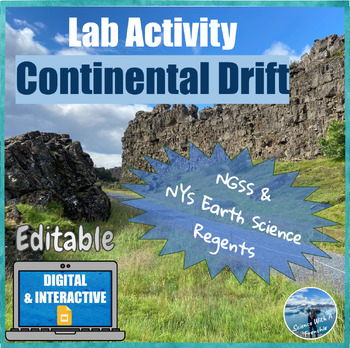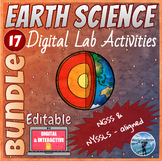The Theory of Continental Drift | Digital Lab Activity | Editable | NGSS
- PDF
- Google Apps™

Also included in
- This one-month-long plate tectonics, Earth's interior, earthquakes, and tsunamis bundle covers everything your students need to know about our dynamic Earth for the New York State (NYS) Regents exam. It includes guided notes with practice questions, teacher presentations, a digital and interactive lPrice $41.60Original Price $52.00Save $10.40
- These digital Earth and Space Science lab activities are ideal for topics where hands-on lab activities may be difficult to complete. They are aligned with NGSS and the New York State (NYS) Earth Science curriculum to prepare the students for the Regents exam. All the labs are editable and interactiPrice $43.50Original Price $57.50Save $14.00
Description
In this Google Slides™ digital lab activity, the students will analyze and interpret data on the distribution of fossils and rocks, and continental shapes to provide evidence of past plate motions and continental drift. This lab activity follows the 5E model with the Engage, Explore, Explain, Elaborate, and Evaluate phases. It is an interactive lab activity with drag & drop activities, video clips, and Regents questions. The key is included.
ESL Strategies: This lab activity is scaffolded for English Language Learners (ELLs):
- Each slide contains a “Translate” hyperlink button to translate the text into any language supported by Google Translate.
- It includes sentence starters to help ELLs structure their answers. The document is editable so you can remove the sentence starters if your students don’t need them.
- The video is available in English and Spanish. Please note that the videos aren’t exactly the same but the content is similar.
Standards: The level of this lab is perfect for 8th-grade or high school. This lab activity aligns with:
- NGSS MS-ESS2-3: Analyze and interpret data on the distribution of fossils and rocks, continental shapes, and seafloor structures to provide evidence of past plate motions.
- NGSS HS-ESS1-5: Evaluate evidence of the past and current movements of continental and oceanic crust and the theory of plate tectonics to explain the ages of crustal rocks.
- New York State Physical Setting/Earth Science Core Curriculum:
- 2.1 - The lithosphere consists of separate plates that ride on the more fluid asthenosphere and move slowly in relationship to one another, creating convergent, divergent, and transform plate boundaries. These motions indicate Earth is a dynamic geologic system.
- NYS Regents Skills: The students use pages 8 & 9 of the ESRT.
Editable: You can edit the text and the data table by clicking on “View” → “Theme Builder”. However, some of the background images aren’t editable due to term-of-use agreements with clipart artists.
Digital: This digital lab activity was created with Google Slide™. It can be used in person or for distance learning.
- Share the Google Slides with your students via your Google Classroom. Make sure you select “Make a Copy for Each Student” while you are creating the assignment.
- NYS teachers: This resource includes a colored copy of pages 8 & 9 of the ESRT.
Related Products:
- Bundles:
⭐ NYS Earth Science Digital Regents Reviews | Growing Bundle ⭐
⭐ NYS Earth Science Digital Lab Activities | Growing Bundle ⭐
- Notes & Workbook:
⭐ Earth's Spheres and Layers | Notes and Workbook | Editable
⭐ Plate tectonics | Notes and Workbook | Editable
⭐ Earthquakes & Tsunamis | Notes and Workbook | Editable
- Digital Reviews:
⭐ Earth's Interior | Earth Science Regents Review | Digital | ESRT Page 10
⭐ Earthquake P-Wave and S-Wave Travel Time | ESRT page 11 | Digital Pixel Art
- Vocabulary Review:
⭐ Plate Tectonics & Crustal Features | Vocabulary Review Game
Follow me for 50% of new resources!
Find me on Instagram!







